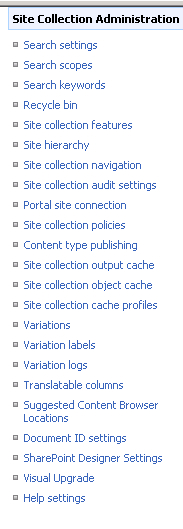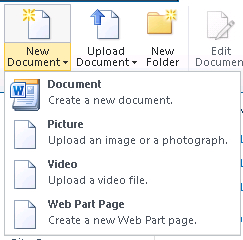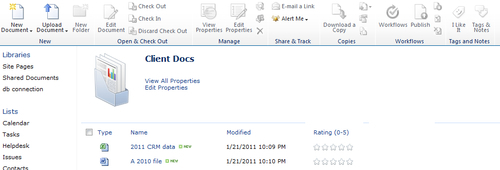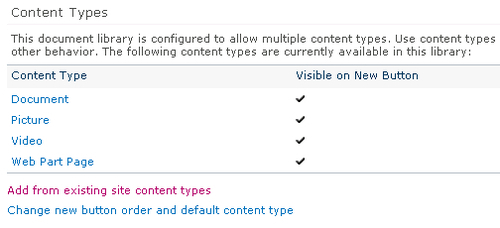In this section you will be introduced to advanced features of libraries. The advanced List settings are covered in detail in Chapter 4.
With previous versions of SharePoint, an underlying complaint with document management was that there was a lack of unique identifiers for documents, and that if a document was moved to another location, any reference to it would not work.
In SharePoint 2010, there is a unique numbering in documents and content as well as the ability to create a unique document ID.
To enable the Document ID Feature, go to the Site Collection Features in the site Collection Administration and activate the Document ID Service.
In the site Collection Administration menu there is a Document ID Service item.

When you click on this you will see the following options available:

To assign Document IDs the following steps should be applied:
- Assign Document IDs: All existing documents and new documents will get an ID.
- Begin IDs with the following characters: This is the 4-12 document ID that you can configure. All that SharePoint will do is adding a - number to the end of this like -1, -2, and so forth.
Document libraries and lists can contain multiple content types. For example, a library can contain both the documents and the graphics related to a project. When a list or library contains multiple content types, creating a new document from the Ribbon in a library can look like this:

The columns associated with all available content types are displayed.
You can define custom content types in a site's content type gallery. A custom content type must be derived, directly or indirectly, from a core content type such as Document or Item. After it is defined in a site, a custom content type is available in that site and in all sites below that site. To make a content type most broadly available within a site collection, define it in the content type gallery of the top-level site. You can also create a custom content type in a content type hub that is defined in a managed metadata service instance. When it is created in a content type hub, the content type will be available to other site collections that are part of web applications associated with that managed metadata service instance.
To allow a library to have multiple content types:
- Click the Advanced Settings in the library or list's settings.
- Select Yes to All management of content types
- Click the OK button.
To add multiple content types to the library/list, follow these steps:
These core content type definitions are starting points, and new content types based on existing ones can be added by modifying existing core types. If you want to use a particular content type, it should be created in the content type gallery of the top-level site, in a site collection. You can create a content type that defines the metadata for:
Then, any document library in your site collection to which you associate the contract content type will include all of these features and will enable authors to create new contracts based on the template.
Content types are organized into a hierarchy that allows one content type to inherit its characteristics from another content type. This inheritance allows classes of documents to share characteristics across an organization, and it allows teams to tailor these characteristics for particular sites or lists.
For example, all customer-deliverable documents in an enterprise might require a set of metadata, such as account number, project number, and project manager. By creating a top-level Customer Deliverable content type from which all other customer-deliverable document types inherit, you ensure that required information, such as account numbers and project numbers, will be associated with all variants of customer-deliverable documents in your organization.
Note
If the content type owner adds another required column to the top-level Customer Deliverable content type, the content type owner can propagate the changes to all content types that inherit from it, which will add the new column to all customer deliverable documents. Content Types can also have specific workflows associated with them.
In Microsoft Office, when a user is editing a document saved in SharePoint, a Document Information Panel is shown at the top of the document. The Document Information Panel, which is displayed in Word, Excel, and PowerPoint documents, enables users to view and change the properties for an individual file, or for a content type that is saved to a document management server such as a Document Workspace site or a library based on SharePoint Foundation. These properties, also known as metadata, are details about a file that describe or identify it. Users can use these properties to organize, identify, and search for documents.

The Document Information Panel displays an editable form of the document's properties on the server.
Along with editing properties in the Document Information Panel, authors who are using Microsoft Word 2010 can insert properties that are defined on the server into their documents. For example, if the document properties include a project manager name, this name can be inserted into the title page, the footer, or anywhere else the name is used in the document. If a new project manager is assigned to a project, the Project Manager property can be updated on the document management server; this updated project manager name will be reflected in every instance of this property that has been inserted into a document.
Metadata or columns is information about a document that is used to categorize and classify your content. Metadata is associated with a content type as a column. Metadata can provide contextual information about your documents by associating it with an author, subject, audience, language, and so on. Unlike properties, metadata is stored as columns and can be indexed and searched on by SharePoint's search engine.
Metadata added at the site collection level can be associated with content types. Using metadata with content types allows all subsequent content types to inherit some or all of its metadata from the parent content type at the site collection level. Additional metadata can then be added at a lower level such as a document.
Each item of metadata that is associated with a content type is a column, which is a location in a list to store information. Lists or libraries are often displayed graphically as columns of information. However, depending on the view associated with the list, the columns can appear in other forms, such as days in a calendar display. In forms associated with a list or library, columns are displayed as fields.
You can define columns for use in multiple content types. To do this, create them in a Column Templates gallery. There is a Column Templates gallery in each site in a site collection. As with content types, columns defined in the Column Templates gallery of a site are available in that site and in all sites below it.
Folder content types define the metadata that is associated with a folder in a list or library. When you apply a folder content type to a list or library, the new command in that list or library will include the folder content type, which makes it possible for users to create folders of that type.
Note
Another use of folders is that they can be configured to apply default metadata values to data stored within the folder. This is often used to automatically categorize information when it is created/ uploaded into the folder, without the user having to enter metadata values.
You can define views in a list or library that are available only in folders of a particular content type. This is useful when you want a folder to contain a particular type of document and you want views in that folder to only display columns that are relevant to the document type contained in that folder.
These are a new feature of SharePoint 2010 and are basically a container for multiple documents to which you can assign certain metadata, and treat as a single entity in many ways. Therefore, you can manage work products that span multiple documents.
Document sets are special types of folders. To create a Document Set:
- Click on the Library Setting page, Advanced Settings.
- Set Allow management of content types? to be Yes.
- Click Add from existing content type.
- Select Document Set Content Type.
- Click the Add button.
- Click the OK button.

You can now add a document set to the library through the New Document Menu in the New Group on the Library Tools Ribbon.
Document sets also include version control, which makes it possible for you to capture the state of the entire document set at various points in its life cycle.

